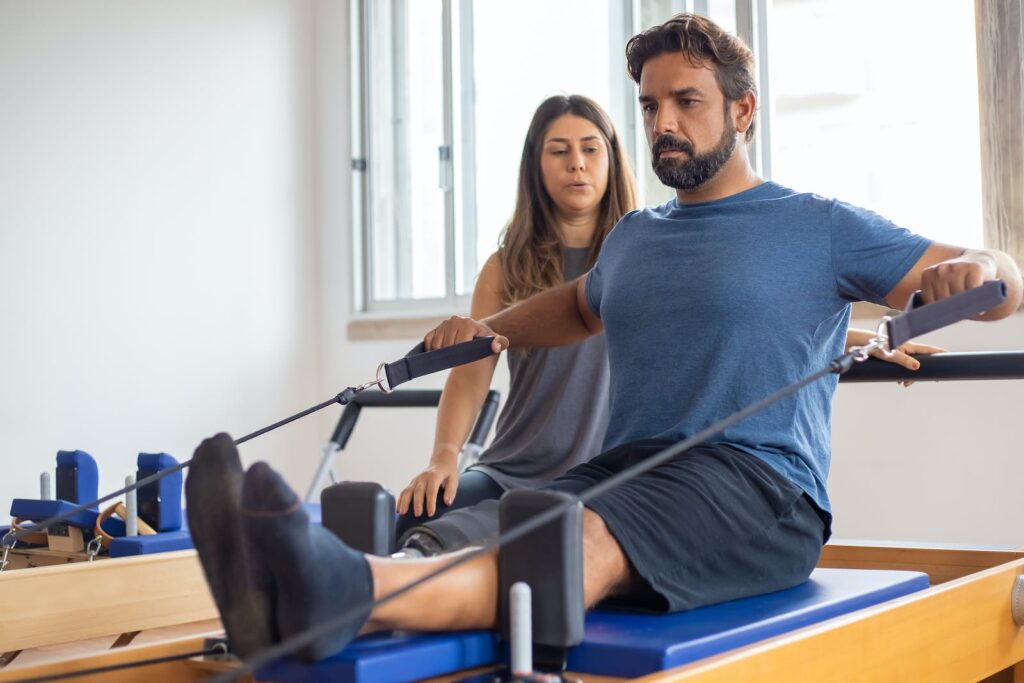Empowering Patients: The Power of Self-Efficacy in Rehabilitation from Injury
Recently, we published a newsletter where we posed an interesting question to our instructors. How do you build connections with your patients? The responses were excellent; as usual, you can see why our instructors connect with their patients as empathetic partners. This has me thinking about how we empower our patients to take better care of themselves. How do we help them remain compliant and build new habits? When thinking of empowering patients, my brain goes to strategies for building patient self-efficacy.
There are great places to go to start to think about this topic. James Clear has a great book called Atomic Habits; it’s a great place to ruminate on how we can help our patients. My brain goes back to grad school and studying Albert Bandura’s social cognitive theory and his concept of self-efficacy. In physical rehabilitation, self-efficacy is pivotal in determining an individual’s ability to recover and regain optimal function after injury. Self-efficacy is one’s belief in their ability to perform specific tasks or achieve certain goals. Self-efficacy has far-reaching clinical relevance in rehabilitation. This blog will explore the significance of self-efficacy in rehabilitation, the psychological and physiological aspects, and the various strategies and interventions that healthcare professionals can employ to enhance self-efficacy, empower our patients, and promote successful recovery.
The Concept of Self-Efficacy
Self-efficacy, a term coined by psychologist Albert Bandura1-2, refers to an individual’s perceived capability to execute a specific task or action to attain desired outcomes. In the context of rehabilitation, it is the belief that one can overcome the challenges posed by their injury and progress towards recovery. Self-efficacy is a multifaceted construct influencing an individual’s motivation, emotional state, cognitive processes, and physical performance.
Psychological Aspects of Self-Efficacy in Rehabilitation
- Motivation and Goal Setting Self-efficacy has a profound impact on motivation during rehabilitation. Individuals with high self-efficacy tend to set ambitious yet realistic goals for their recovery. They are more likely to be persistent and resilient in the face of setbacks, maintaining a positive attitude and commitment to their rehabilitation program. This motivation is essential for achieving long-term success in rehabilitation3-5.
As clinicians, we can engage our patients in goal-setting activities. Helping our patients set reasonable goals, monitoring progress toward those goals, and celebrating the successes along the path, we can help our patients feel empowered and motivated. Healthcare professionals must collaborate with patients to set goals aligning with their self-efficacy level, ensuring they remain motivated and engaged in rehabilitation. - Emotional Well-Being: One’s belief in their ability to recover affects their emotional state. High self-efficacy can reduce anxiety, depression, and stress often associated with injuries, contributing to a more positive emotional outlook6. A positive emotional state can, in turn, promote faster recovery by reducing stress-related factors that hinder the body’s natural healing processes.
- Coping Mechanisms Individuals with strong self-efficacy tend to use more effective coping strategies to deal with pain and challenges in the rehabilitation process. They are better equipped to manage pain and discomfort, which is crucial for adhering to rehabilitation protocols and preventing unnecessary setbacks7.
Physiological Aspects of Self-Efficacy in Rehabilitation
- Pain Perception Self-efficacy has been shown to modulate pain perception. Research suggests that individuals with high self-efficacy experience less intense pain and are better able to endure discomfort during rehabilitation. This is likely due to their enhanced ability to focus on positive outcomes and their capacity to distract themselves from the pain8-9.
- Physical Performance Self-efficacy can have a direct impact on physical performance. Individuals who believe in their ability to complete exercises or activities are more likely to exert themselves, push their limits, and achieve better results in their rehabilitation. Their confidence can translate into increased strength, range of motion, and functional improvement10-11.
Clinical Relevance of Self-Efficacy
- Assessment and Measurement In clinical practice, assessing an individual’s self-efficacy is crucial. Healthcare professionals can use various validated instruments to gauge a patient’s self-efficacy related to specific rehabilitation tasks. Understanding a patient’s self-efficacy helps clinicians tailor treatment plans and interventions accordingly 4.
- Intervention Strategies Enhancing self-efficacy is a crucial objective in rehabilitation. Various strategies can be employed to boost an individual’s confidence in their ability to recover 4,7:
- Setting Realistic Goals: Collaboratively establishing achievable rehabilitation goals can empower patients and increase their self-efficacy.
- Providing Positive Feedback: Offering praise and reinforcement for progress made during rehabilitation can bolster self-efficacy.
- Education and Information: Informing patients about their condition and rehabilitation can reduce uncertainty and increase self-efficacy.
- Cognitive-Behavioral Therapy: Techniques such as cognitive restructuring can help individuals overcome negative thought patterns and self-doubt.
- Social Support Social support from healthcare providers, family, and friends can significantly impact a patient’s self-efficacy. Encouragement and understanding from their support network can reinforce an individual’s belief in their recovery, making them more likely to adhere to rehabilitation programs and persevere through challenges12.
Healthcare Providers /Healthcare professionals play a vital role in fostering self-efficacy. They must provide clear, concise information, set achievable goals, and instill patient confidence. Demonstrating empathy, listening to concerns, and offering support can help patients feel more in control of their recovery.
I hope these concepts resonate with you, and if you need more resources to explore, check out the links below for more exploration of self-efficacy and Injury. Keep connecting and empowering your patients.
References
- [PubMed Link] Bandura, A. (1977). Self-efficacy: Toward a unifying theory of behavioral change. Psychological Review, 84(2), 191-215.
- [PubMed Link] Bandura A. Applying Theory for Human Betterment. Perspect Psychol Sci. 2019 Jan;14(1):12-15. doi: 10.1177/1745691618815165. PMID: 30799756.
- [Publisher Link] Gangwani, Rachana, Amelia Cain, Amy Collins, and Jessica M. Cassidy. “Leveraging Factors of Self-Efficacy and Motivation to Optimize Stroke Recovery.” Frontiers in Neurology 13 (2022). https://doi.org/10.3389/fneur.2022.823202.
- [Publisher Link] Picha, Kelsey J., and Dana M. Howell. “A model to increase rehabilitation adherence to home exercise programmes in patients with varying levels of self‐efficacy.” Musculoskeletal Care 16.1 (2018): 233-237.
- [PubMed Link] Pisters MF, Veenhof C, Schellevis FG, Twisk JW, Dekker J, De Bakker DH. Exercise adherence improving long-term patient outcome in patients with osteoarthritis of the hip and/or knee. Arthritis Care Res (Hoboken). 2010 Aug;62(8):1087-94. doi: 10.1002/acr.2
- [Publisher Link] McCaffrey, A., M. Mrazik, and R. Klassen. “The relation between self-efficacy, injury and fear of injury among elite athletes.” British journal of sports medicine 48.7 (2014): 636-636.
- [Publisher Link] Connolly, Fiona R., Leanne M. Aitken, and Marion Tower. “An integrative review of self‐efficacy and patient recovery post acute injury.” Journal of advanced nursing 70.4 (2014): 714-728.
- [Publisher Link] Jackson, Todd, et al. “Gender differences in pain perception: The mediating role of self-efficacy beliefs.” Sex Roles 47 (2002): 561-568.
- [PubMed Link] Bandura, Albert, et al. “Perceived self-efficacy and pain control: opioid and nonopioid mechanisms.” Journal of personality and social psychology 53.3 (1987): 563.
- [PubMed Link] Bosscher, Rudolf J., et al. “Physical performance and physical self-efficacy in the elderly: A pilot study.” Journal of Aging and Health 7.4 (1995): 459-475.
- [Publisher Link] Adegoke, B. O. A., and A. O. Ezeukwu. “Pain intensity, self-efficacy and physical performance in patients with chronic low back pain.” International Journal of Therapy and Rehabilitation 17.10 (2010): 524-534.
- [PubMed Link] Pjanic, Irena, et al. “Predictors of depressed mood 12 months after injury. Contribution of self-efficacy and social support.” Disability and rehabilitation 36.15 (2014): 1258-1263.





